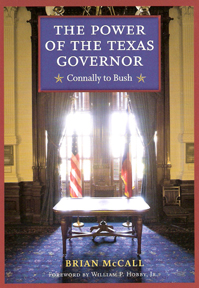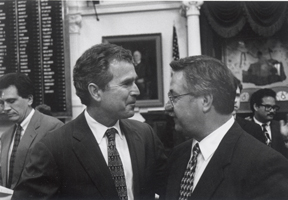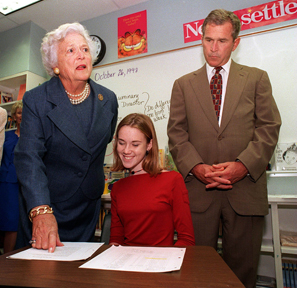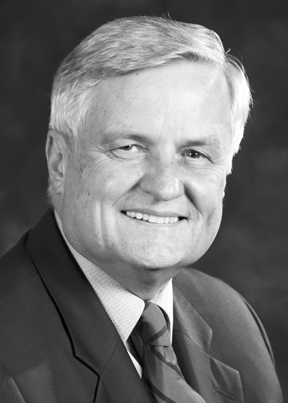Bush comes back to the place where his legacy is at least debatable.
By MATT PULLE
It was the afternoon before Thanksgiving in Austin, and George W. Bush – then in his first term as governor and enjoying record-high approval ratings – was in his stately office at the capitol. He usually worked in a blue suit and in cowboy boots, which he often kicked up on his desk to make visitors feel comfortable. And usually they did feel at ease with the governor, whether they were rural Republicans who hung pictures of themselves and him on their office walls or Democrats who felt they could at least talk to Bush, even if they had just sparred with him on a bill. 
That day, Garnet Coleman, a young state representative from Houston, dropped by. A well-respected Democrat who would go on to become the chair of the legislative black caucus, Coleman didn’t have any agenda on his mind. He just wanted to, in his words, “shoot the bull.” Though he had scrapped with Bush on several bills, Coleman still found him to be an affable, honest leader, and the two were chummy enough to trade cigars.
At first, Coleman and Bush merely chatted on that lazy November afternoon, but the conversation soon turned serious. A Dallas lawmaker had proposed reducing the state-required minimum staffing levels for child care centers. Bush asked Coleman his opinion.
The son of a prominent Houston physician, the 30-something lawmaker had made it onto Texas Monthly’s list of the state’s best legislators. “Coleman is a hero,” the magazine had proclaimed in 1995, during the governor’s first legislative session. So Bush knew that if he asked Coleman a question about policy, he was going to get an honest, direct answer – neither a yes-man’s dutiful nod nor a kneejerk liberal’s automatic “no.”
Coleman talked to the governor about research into brain mapping. A recent study had concluded that children become predisposed to violence and anti-social behavior if they do not receive enough adult attention at a very young age. Slashing the number of workers at day care centers might be a business-friendly proposal, he said, but in the long run it would cost the state millions of dollars if neglected kids turn to a life of crime. The governor merely listened without arguing, then asked where he could obtain a copy of the brain-mapping study.
Within a few weeks, Bush had distributed the study to his top aides, and when he spotted Coleman shortly after that, he made it a point to show the legislator they had read it and grasped its implications. The measure to reduce the number of child care workers faded away. Coleman and Bush would wind up disagreeing on several core issues, from welfare reform to children’s healthcare, but the state representative felt that the governor, as hokey as it might sound, always wanted what was best for his state.
 “I can’t forgive him for Katrina, I just can’t,” Coleman said a few days ago. “But I’ll be honest. His time in Texas was a good time.”
“I can’t forgive him for Katrina, I just can’t,” Coleman said a few days ago. “But I’ll be honest. His time in Texas was a good time.”Eight years after leaving here as a popular, charismatic, and well-regarded governor, respected by some of the most powerful Democrats in the state, Bush returns to Texas this month as the most despised and polarizing president in the last half-century. Turns out, no mission was accomplished. For three years now, his approval ratings have mined record lows in the wake of his inept response to the devastation of New Orleans at the hands of Hurricane Katrina, his calamitous and unwinnable war in Iraq, and his administration’s starring role in helping cause, through its doddering economic policies, the country’s worst financial implosion since the Great Depression.
So it may come as something of a shock that portions of Bush’s legacy as governor, even viewed with a jaundiced eye, still hold up. He defied the rigid elements of his own party, worked eagerly and effectively with all types of Democrats, and pursued – with a few key exceptions – policies and reforms that were popular with Texans. That’s not to say he was a world-beater as governor. The high marks often given to him on his administration’s fiscal stewardship during that time owe a good deal, oddly enough, to the rosy national economy of the Clinton era, while Bush’s poll-tested and often self-serving agenda often intensified the state’s long-running problems.
But few people, even those who regard him as a truly miserable president, think that he really stank as the head of our state. It helped that he had a Democratic majority to keep him in check and held an office whose constitutional powers didn’t allow him to even think about wiretapping American citizens. Still, even taking such mitigating circumstances into account, Bush was a remarkably successful politician here, fulfilling his campaign promises within a year and being the first Texas governor to win re-election in more than two decades. Whether his agenda was victory of style over substance or a blueprint for lasting reform is an arguable point. But at least we can argue it. Today, there aren’t many people seriously willing to defend the merits of Bush’s time in Washington.
“You can say objectively that he was a good governor in that he mostly got done what he wanted to get done and wound up being able to use his record to get elected president,” said Ross Ramsey, editor of Texas Weekly, a well-read political newsletter, who covered Bush in the 1990s. “If you ask most Texans, what do you think of George W. Bush as governor, they often don’t point to a particular issue or program; they instead tend to point to whether they liked him or not.”
It’s almost impossible to remember – like recalling the details of your high school prom – that there was a time when George W. Bush was a fresh, energetic newcomer on the political stage. At first, few people thought he could topple incumbent Ann Richards, who had become a national figure through her wicked tongue and forceful leadership. But once Bush hit the campaign trail, it was clear that the candidate, though a Yale-educated son of a president, had the ability to connect to regular, hard-working voters.
“It was a brilliant campaign – he hit the whole state of Texas, including every little county courthouse,” said Fred Meyer, who served as head of the Republican Party in Dallas County and statewide. “He comes across very much as a Texan, and the good ol’ boys in those courthouses just really liked him. At that point we had to do everything we could to get him to stop in Dallas. When he finally came here, we had a room at the Westin Hotel, and about 1,000 people came to hear him speak.”
After Bush was elected governor in 1994, however, he acted more like a shy, modest leader than a looming presidential candidate with star power to burn. He met with nearly every member of the Texas House and Senate before the start of the legislative session and asked them about the bills they were filing. He didn’t lead them on or pledge support he couldn’t deliver; he just sat back and listened as if he were meeting with old friends. In turn, they invited him to fund-raisers and high school graduations.
“He was the son of a U.S. president, but if he needed to meet with someone, he’d be just as likely to go to a House member’s office and kibitz with their staff,” said Brian McCall, a House Republican from Plano, who recently helped lead the movement to unseat Speaker Tom Craddick. “He’d even call House members and congratulate them on a favorable story that was in the newspaper.”
This was a more humble, amiable Bush than the one the world saw in Washington. That measured persona, according to some on both the right and left, was a mere calculation to polish his image into that of an appealing presidential candidate. It’s hard to dismiss that suggestion entirely. But even if it’s true, and Bush’s warm façade as governor was a fabrication, it occasionally led to good policy and positions.
Shortly after his defeat of Richards, when Bush’s name began to pop up as a future presidential candidate, the Houston Chronicle asked him what he thought of Proposition 187, a California initiative to deny benefits to illegal immigrants. Here the governor signaled, in his own inimitable, clunky way, that he was not a Rush Limbaugh-style Republican. “I am not for 187,” Bush said. “I’m opposed to not educating children who are already here.”

As a candidate for governor, Bush campaigned on only four specific issues: tort reform, welfare reform, toughening laws against juvenile offenders, and returning control of education to local school boards. These ideas were straight out of the Republican playbook, and some were better thought out than others. But if Bush wanted to succeed with any of them, he needed the support of Democrats who controlled the legislature, particularly Lt. Gov. Bob Bullock.
An iconic figure whose prominence and influence may well have eclipsed nearly all of the governors with whom he served, Bullock saw himself as a mentor to Bush, who, in turn, looked to the lieutenant governor to help him demystify the arcane customs of the Texas Legislature. Their relationship is now a part of Texas lore. Bush, the wide-eyed neophyte, and Bullock, the wily, combustible pol, hit it off like a couple in a romantic comedy: Their affection blossomed the moment their eyes locked.
“Frankly,” Bullock told The Washington Times in an interview about Bush, “he’s one of the nicest men I’ve ever worked with – a very decent person and a man who cares deeply for his state and exhibits it.”
Along with House Speaker Pete Laney, also a Democrat, Bush and Bullock met for breakfast every Wednesday, and during the highly productive 74th Legislature session in 1995, the three worked together seamlessly. When the session wrapped up, Bush signed into law bills that made good on all the core issues of his campaign, though he was forced to give a lot on welfare reform.
As a result, Bush’s approval ratings soared. Even the Austin press corps, many of whom considered the new governor a lightweight, gave him his due, handing him nearly perfect marks for his first session.
The reality is that part of the Bush agenda consisted of quick fixes rather than real reforms. But that wasn’t part of the discussion. People were more caught up in the unusual spectacle of a newbie GOP governor and possible presidential candidate working harmoniously with two Democratic stalwarts.
“The best way to envision how Republican Gov. George W. Bush, Democratic Lt. Gov. Bob Bullock, and Democratic House Speaker Pete Laney work is as one political organism,” read a Dallas Morning News editorial. “Just as an organism has parts that perform different functions, so the state’s top three officials have distinctive roles … . The basic unity of this threesome ensured action on several fronts, including education and tort reforms. All three deserve A’s for their first session together.”
The governor’s bipartisan bent didn’t stop with the state’s two most powerful Democrats. Consistently, Bush made it seem as if he enjoyed working with the other party.
Coleman, the House Democrat from Houston, said that Bush didn’t merely want to win a bill by one vote. “There was a necessity to come to an agreement,” he said. “It wasn’t, ‘I have to deal with you, so I’m going to deal with you.’ He wanted to involve everybody because he thought that led to good public policy.”
Coleman thinks that Bush has been a terrible president, and he doesn’t have entirely good memories about his time as governor. The two fought on key issues like the underpinnings of CHIP, a healthcare program for low-income children. But Coleman said that the Bush that he knew was far more moderate and reasonable than the one he sees today. Case in point: In Bush’s first term, Coleman proposed a mental health parity bill that required insurance companies to cover treatment of illnesses like schizophrenia and bipolar disorder.
That’s exactly the kind of progressive measure, Coleman said, that he could never get passed today. Well, not only did Bush support Coleman’s legislation, he sent the House member a picture of the ceremony when he signed it into law.
“If you had the opportunity to talk to him about the merits of any proposal, he would listen,” he said.
 Toby Goodman, a former House Republican from Tarrant County, carried some of Bush’s most important bills in the 1995 session. He was impressed that, unlike other governors he’d served with, Bush would attend committee meetings and visit House members in their offices rather than summoning them to his own quarters.
Toby Goodman, a former House Republican from Tarrant County, carried some of Bush’s most important bills in the 1995 session. He was impressed that, unlike other governors he’d served with, Bush would attend committee meetings and visit House members in their offices rather than summoning them to his own quarters.
The governor treated the legislators as equals, in fact.
In 1999, when Bush was running for president, his office was holding up one of Goodman’s important bills in the Senate. Goodman marched in and yelled at Bush, railing that the office was “backstabbing him.” Goodman even added that if the election were tomorrow, “I wouldn’t vote for you.”
Bush didn’t take Goodman’s harsh words to heart. The two had argued before and usually settled it with a cigar. This time was no different: Bush wound up signing Goodman’s bill.
Goodman, an Arlington attorney, said that as governor Bush led from the center and wasn’t afraid to pick a fight with his party’s biggest supporters. In Bush’s juvenile crime bill, which Goodman carried in the House, the governor insisted on keeping intact a provision that would have thrown kids in jail for 72 hours if they were caught with firearms. Goodman told him that would rile the conservative rural sensibilities of the West Texas delegation and the National Rifle Association, but Bush wanted him to give it a whirl.
Goodman lost the point by a hefty vote and wound up having to compromise. Still, Bush’s willingness to offend his base was typical of his principled, practical approach to government – at least as the former lawmaker sees it.
“I’d say he was probably the greatest governor in Texas since the late 1940s. He reached across the aisle, he did not raise taxes, he delivered on his agenda, and the economy grew,” Goodman said. “You had budget surpluses, and when you had a downturn in the economy, he dealt with it without cutting vital programs – which you can’t say about the current administration or the ones before.”
But what Goodman viewed as pragmatic, others regarded as unprincipled. Tom Pauken, head of the Texas GOP during Bush’s first term as governor, said he met the future president when Bush was a student at Yale and Pauken was national chairman of the College Republicans. Pauken wasn’t particularly impressed with him then, and he never did come around. Whether Bush was pushing something that social conservatives supported (such as requiring parental consent for minors seeking abortions) or working collegially with Bullock and Laney, Pauken said, the governor cared about the political ends and little else.
“He’s a partisan in the sense that he and Karl Rove want people who will help them get where they want to go, but not in the sense of having a philosophical compass,” Pauken said. “It was more a set of alliances with some Democrats and some Republicans but with no firm convictions either in Austin or in Washington.”
If Bush’s style as governor still evokes warm feelings for many, the long-term results of his policies are a bit harder to judge. The 1995 session, the first of three during his term, is really the only one that produced much to talk about. In 1999, his last year in office, Bush was mostly a no-show, because he was concentrating on preparing a run for president. And in between, during the 1997 session, the governor endured his only major setback. Having already signed two of the largest tax cuts in Texas history, Bush tried to change the state’s tax structure and reform the school finance system. The goal was to provide more money for education by reducing the property tax rate, while essentially adding more business taxes and closing loopholes.
Bush’s proposal, which dominated the session, was a relatively progressive one. Many believe that Texas relies too heavily on property taxes to fund public education, creating yawning gaps between rich and poor school districts. A successful revamping of school finance could have been the centerpiece of Bush’s legacy – a measure that conservatives and liberals could both rally around. But here the governor’s political skills finally failed him, as he laid out a complicated, ambitious initiative without doing his usual legwork to make it palatable. As a result, business interests lobbied vigorously against the measure, and the legislature came up with a separate, more conventional plan that did little to address the deep inequities in the system.
“Bush proposed a broad tax bill that was fairly easy … to kill,” said Ramsey, the Texas Weekly editor. “It was the one time he didn’t sit down with Laney and Bullock to work things out beforehand.”
So what did Texas get from the Bush governorship that he – or his enemies – can still point to as a lasting legacy?
On the plus side, from the point of view of the moderate, pro-business issues he ran on, Bush’ accomplishments are still at work. He signed massive tax cuts and a bill to make it harder for businesses to be sued. Those positions were popular and were the major reasons he was re-elected with 70 percent of the vote in a state that usually loves to hate its governors.
In contrast, progressives say that Bush’s tax cuts have caused a series of state government failings. The abuse scandal that plagued the Texas Youth Commission, in which juveniles were found to have been abused and molested, has its root causes in the agency’s historic lack of funding.
Other central planks from the Bush agenda haven’t lived up to their billing. His education measures, which centered on shifting more control to local school boards, creating more charter schools, and mandating more testing and accountability, have proven to be far more controversial than anyone would’ve imagined. Many charter schools have been outright disasters, run by charlatans with little to no experience in a classroom. Meanwhile, some local school boards have proven to be incompetent at managing the business of public education. That could include a small-town board like Wilmer-Hutchins, which was shut down after accusations of rampant test fraud, or a huge one like the Dallas Independent School District, which recently had to fire teachers after overspending its budget by tens of millions of dollars.
But it’s Bush’s emphasis on testing, testing, and more testing that is the foundation of his education legacy in Texas, such as it is. That program managed to accomplish a rare feat: uniting parents, teachers, and principals in support of a long list of serious grievances over how Bush’s programs have influenced the way educators must do their jobs.
It’s not that all educators and parents dislike the accountability measures that Bush helped put in place. (It’s worth noting that it was Bush’s predecessor, Ann Richards, who started the move toward a more rigorous monitoring of public education.) Some maintain that pressuring schools to improve their students’ performance on the state test (called TAKS) and publicly reporting schools’ rankings in the local newspaper forces principals and teachers to make sure that all kids – not just the smart, diligent ones – are learning.

But education professors say that, in the classroom, Bush’s education initiatives – which ultimately became the template for the federal “No Child Left Behind” law – simply have not paid off. Linda McNeil, director of the Center of Education for Rice University and formerly on the faculty at Harvard, has conducted detailed studies on the accountability system Bush engineered as governor. McNeil and her colleagues have spent time inside schools and classrooms, interviewed teachers and administrators, and looked at student data. What she found was discouraging.
“The high-stakes accountability system based on statewide standardized tests has reduced the quality of education,” McNeil wrote in an e-mail. “Many schools raise their scores by substituting multiple-choice test drills for a rich and robust curriculum. This may produce short-term gains in test scores, but those do not hold up as students move up the grades.”
Bush’s juvenile crime bill has also faced renewed scrutiny in recent years. During the period leading up to its passage, the sordid, violent acts of youthful offenders were continually in the headlines. The Houston Chronicle reported that juvenile arrests in Texas increased by 43 percent from 1985 to 1993, while homicides committed by juveniles jumped threefold.
So there was a hue and cry to address the problem of young criminals, and Bush’s solution was to put them in jail sooner and longer. The juvenile justice bill lowered the age at which juveniles could be tried for murder and other first-degree felonies, mandated the construction of more youth detention facilities, and allowed inmates as young as 16 to be transferred to state prison. Altogether, Bush asked for six specific items in his juvenile initiative, and he signed every one of them into law.
Today though, some policy experts say the bill’s emphasis on trying juveniles at younger ages is outdated and counterproductive.
“I can say with confidence that the ‘tough on crime’ approach to juvenile justice is out of line with evidence-based practices around the country on what is effective for dealing with juveniles,” said Jodie Smith, public policy director at Texans Care for Children.
Smith said that a more nuanced system that doesn’t just give up on youthful offenders often proves to be more effective. “What’s been shown to work for juvenile delinquency is a rehabilitative approach that focuses on a strong therapeutic component including mental health issues, chemical dependency issues, trauma, and rehabilitation.”

But Goodman, the Tarrant County Republican who authored the juvenile justice bill, said that Bush’s approach to juvenile crime wasn’t only about toughening sentences and building jails. Several provisions in the bill required care for mentally ill offenders while outlining a system of progressive sanctions in place of uniform sentences for all offenses. In fact, Goodman said, the bill, in whose crafting Bush himself played a direct and constant role, has been copied by other states.
In the long run, Bush’s tort reform package could prove to be the most successful policy accomplishment of his administration in Texas. Even the trial lawyers, whose practice the bill has curtailed, don’t readily complain about it, choosing instead to focus on moderating some of the stricter regulations imposed since Bush left for Washington. Tort reform, which addresses how lawsuits are tried and adjudicated, took off in the 1990s as lawyers, typified by the Jackie Chiles character in Seinfeld, become the butt of jokes for filing ridiculous lawsuits. Of course, those attorneys also helped expose – and still are exposing – grave injustices from polluting refineries to nursing home abuse, but that got lost in the debate.
Many observers dismissed Bush’s chances of making substantial changes in the civil side of the justice system. Democrats, long the party of the plaintiff’s bar, still controlled both chambers of the legislature, and Laney was considered a key ally of litigators. But Bullock was more receptive to the idea, and together he and the governor managed to win over the speaker. As a result, in the 1995 session, the legislature passed a tort reform package of eight bills, marking a major political victory for the new governor and the business-friendly interests who helped lead the charge.
“It was a huge battle to get ourselves taken seriously, and the margin on that was provided by Bush,” said Hugh Rice Kelly, counsel for Texans for Lawsuit Reform. “The governor was strongly behind tort reform and helped turn the opinion around [in] the legislature that something real was going to happen and that he didn’t want to just dust up some minor statutes and declare victory.”
Some of the bills were commonsense measures. For example, a plaintiff who was largely responsible for his own injury – think of someone showing up drunk to the assembly line – was barred from receiving damages for any injury incurred on the job. Another bill capped punitive damages, making it harder for sympathetic juries to come up with awards seemingly crafted out of thin air. The measure was meant to prevent plaintiffs from pressuring businesses into settling frivolous lawsuits out of court for fear of what an arbitrary jury might do.
But the centerpiece of Bush’s tort package was venue reform. It seems an arcane issue: where a lawsuit can be filed. But Kelly, the tort reform advocate and a retired corporate lawyer himself, said that before Bush’s package passed, a plaintiff could sue a corporation anyplace it had an agent or a representative. For an insurance company, railroad, or automotive manufacturer, that could mean just about anywhere in the state.
Kelly said that some places in Texas had a reputation for handing outrageous awards to plaintiffs, particularly Matagorda County, on the Gulf. Before Bush’s tort reform measures, lawyers could file their cases at friendly venues, regardless of where an injury had actually occurred. Under the new rules, a suit had to be filed in the jurisdiction where the incident occurred or where an allegedly dangerous product was sold.
Today, even trial attorneys admit that this part of tort reform was overdue. “I took full advantage of the previous venue laws and was sorry to see them change, but from the standpoint of what was good policy, I can’t say it wasn’t fair,” said Nelson Roach, the collegial president of the Texas Trial Lawyers Association. “Venue laws, as they existed in 1995, were slanted to allow some plaintiffs to game the system, and that needed to be fixed.”
While Bush largely stuck to a Republican DELETE devoid of extreme themes, he did sometimes slide further to the right, particularly on environmental issues. His administration allowed some of the state’s most noxious polluters to be exempted from emissions regulations. His appointments also revealed a similar pro-industry bent. In one particularly egregious case, Bush named Ralph Marquez, who worked for Monsanto and lobbied for the chemical industry, to the Texas Commission on Environmental Quality (TCEQ), roughly the equivalent of the state EPA.
TCEQ regulates polluting industries like cement kilns and oil refineries. It crafts clean air plans for entire regions and approves permits for power plants. Under Bush, TCEQ was largely blamed (or credited, by certain folks) for going easy on industries that regularly broke the law.
“The most stunning thing was the lack of enforcement,” said Tom “Smitty” Smith, one of the state’s most effective environmentalists and the director of Public Citizen in Texas. “There was a study done by the state auditor that found that, on average, the amount of a fine during the Bush administration was one-eighth the [size of the financial] benefit to companies of illegally emitting toxic substances. Under the guise of budget-cutting, inspectors weren’t allowed to work overtime, signaling to polluters that they could get away with murder.”
Smith does credit Bush with pushing for and signing a bill that restricted dangerous emissions from power plants – a move largely tied to his presidential ambitions – and with promoting renewable forms of energy. But his administration’s first instinct was usually to treat industries, even ones that ran afoul of the law, as friends, if not customers.
On social issues too, Bush occasionally flirted with the fringes of his own party. Sometimes it was on silly stuff like when, in the middle of his presidential run, the governor of the nation’s second-most populous state issued the following proclamation: “Therefore, I, George W. Bush, do hereby proclaim June 10, 2000, Jesus Day.” Alas, the governor never did get around to selecting a 24-hour period to honor Moses or Muhammad.
On other matters though, church and state activists say that Bush’s social conservatism had more serious consequences. Dan Quinn, spokesman for the Texas Freedom Network, which often spotlights the encroachment of religion onto public policy, said the Bush administration excessively promoted abstinence-only sex education. That led to school districts neglecting other forms of safe-sex instruction, like the proper use of condoms. No wonder, Quinn said, that Texas often has the highest rate of teen pregnancies in the country.
As many see it, Bush’s presidential ambitions had a mixed effect on his tenure as governor. At times, they prompted him to lurch to the right, particularly when it came to placating social conservatives with measures like “Jesus Day.” More often than not, though, the prospect of having to win a general election seemed to nudge him toward the center. His record as governor showed none of the really harsh, civil-liberties-limiting initiatives that he promoted or allowed as president, such as sanctioning torture.
Many of Bush’s initiatives as governor deserve criticism, including some that clearly backfired or prompted a messy range of unintended consequences. But unlike President Bush, Gov. Bush basically governed as he said he would. Texans, at least the vast majority who voted for him twice, got what they wanted: a moderate, corporate Republican with a focused agenda. And it’s worth noting that while states like New York and California struggle with enormous budget deficits, Texas is on solid financial footing. Bush’s business-friendly policies, while not perfect, have played a role in keeping the state in the black.
You have to wonder if Bush himself wishes he’d never left Austin. Rightly or wrongly, he was becoming an iconic figure in Texas. Here, unlike in Washington, he was a genial figure with a knack for getting the political parties to come to terms on bold, influential legislation. And he only had to work every other year.

McCall, the Plano legislator, just finished a book called The Power of the Texas Governor: Connally to Bush. The Republican argues that Bush, through his sheer force of personality, managed to expand the limited powers of the governor’s office and to have a decided impact on the state. It also helped that he absolutely loved his job.
McCall tells a story about how Bush, just a few months after he was elected president, placed a call to his successor, Gov. Rick Perry.
“Do you remember when I told you being governor of the state of Texas was the best job in the world?” Bush asked.
“Yes, Mr. President,” Gov. Perry said.
“Well,” Bush said, “it is.”
Matt Pulle is a Dallas-based freelance writer.











